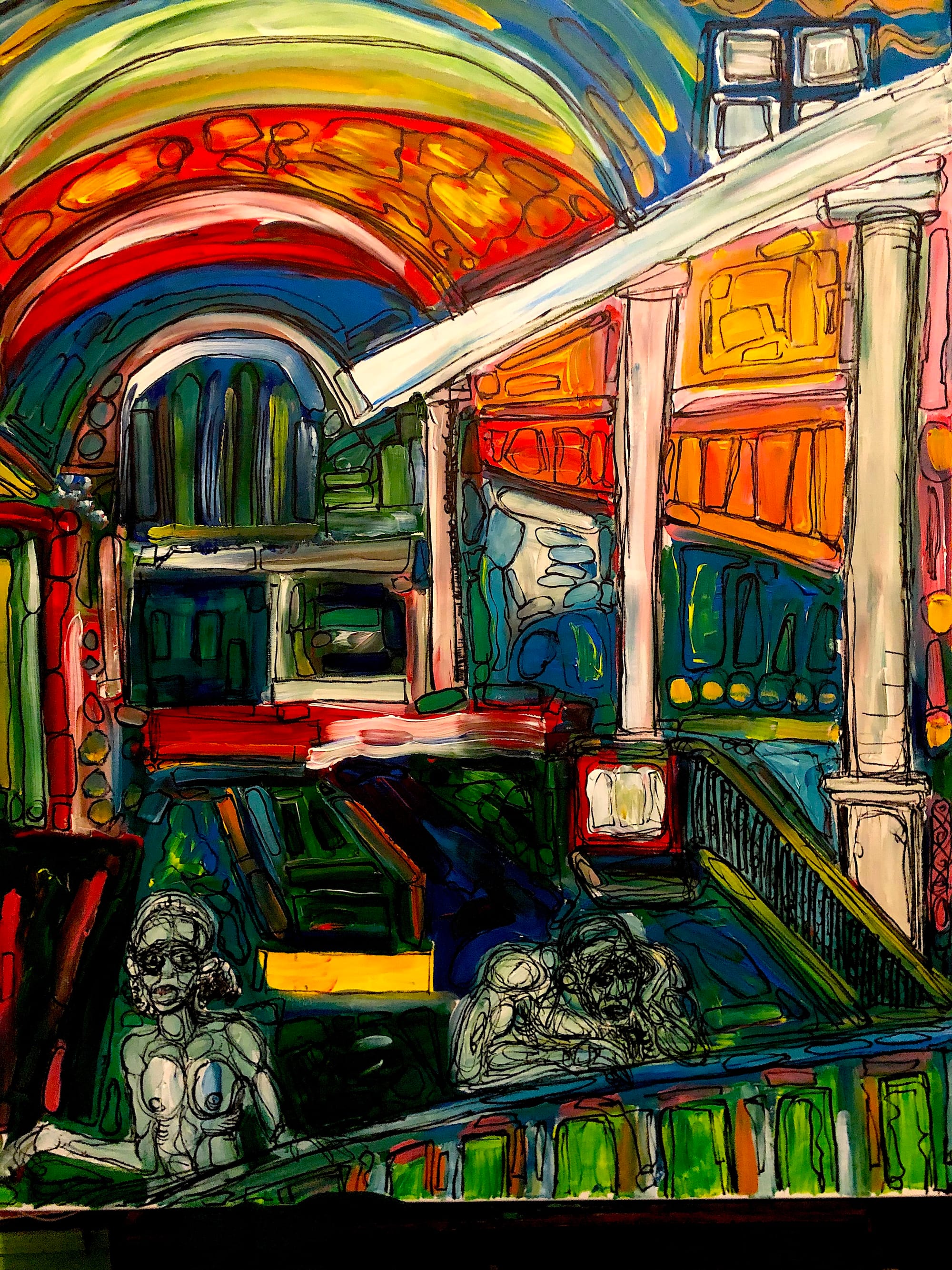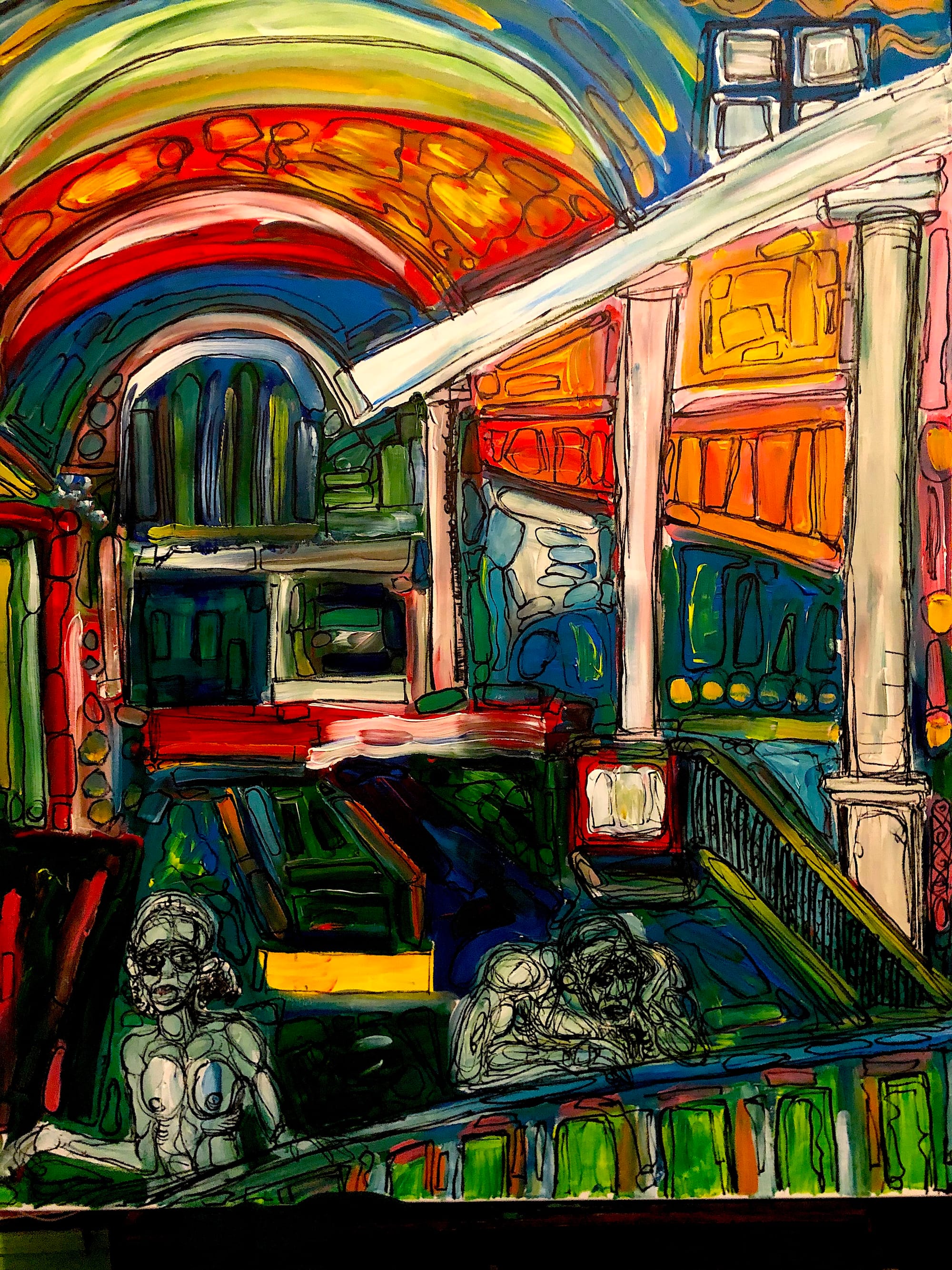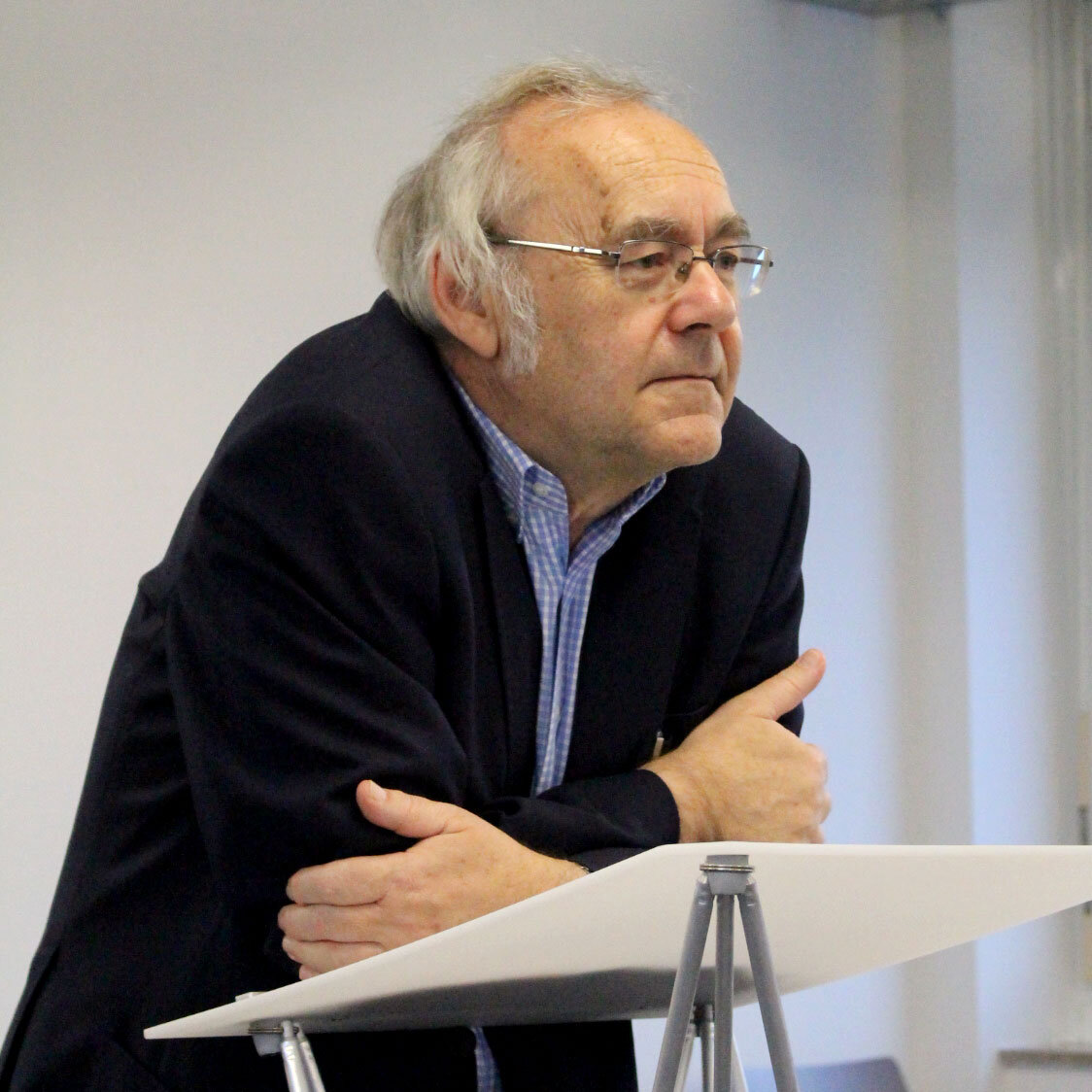The Beyond of Philosophy 9


64. In the Dualizing Mode of Speech the ‘language-distinct’ object of discourse is introduced into the discourse with the help of a rudimentary description.
The denotation of the discourse-object itself is however ‘language-distinct’. The descriptions-in-question can only be made after the denotation of the object.
But Dualizing Speech must not restrict itself to presuppose the object to the descriptions-in-question. It must moreover request that the object must be given already before the start of the discourse, before the denotation of the object.
Only this way it is warranted that the descriptions have no determining or even constitutive effect on the object.
Only this way the identity of the object can be protected against ‘its’ descriptions.
And only this way it can be ensured that the discourse is directed towards the object: The object is already before the start of the discourse so, as it (therefore) will, or at least could, be seen in the best possible, namely the (most) adequate variant of discourse.
65. Each request of the kind that the object must be given before the denotation of the object results in a (re)new(ed) denotation of the object. This request should therefore be changed so that the object has to be given already prior to each request of this kind. But that would again trigger an infinite regress.
(If it is claimed that the object is, and has to be, given already before the denotation of the object, then the object is thereby denoted already before the denotation of the object.)
66. This infinite regress has hardly ever been noticed, because the ‘language-distinct’ object is almost generally accepted as a presupposition of discourse.
A discussion between an idealist/constructivist variant and a realist variant of dualism may well take place: but the topic of this discussion is not if a ‘language-distinct’ object has to be presupposed or not, but how the ‘language-distinct’ object is pre-given: language-independent or – constituted through language – language-dependent.
The basic principle of dualism is recognized just the same in both, realism and constructivism/idealism.
67. The presupposition of a ‘language-distinct’ object becomes justified through the consequences of this presupposition.
(Of course one could try to justify this presupposition through the consequences following from not presupposing a ‘language-distinct’ object: If no ‘language-distinct’ objects are presupposed, the identity of the objects against their descriptions is lost. With that the traditional decision basis for the determination of truth and adequacy of diverging descriptions crumbles/disintegrates.)
The objections brought forward from dualism against nondualism either rely on the insinuation that the Non-dualizing Mode of Speech does not accept the presupposition of a ‘language-distinct’ object, but only the consequences of such a presupposition, or that the Non-dualizing Mode rejects the consequences of such a presupposition, but makes the presupposition nevertheless.
68. Before the Dualizing Mode of Speech introduces the object with the help of a (rudimentary) description into the discourse, the object is ‘language-distinct’ and undescribed. The apple lying on the table can only then lie on the table before any description – and therefore as well before the rudimentary description – if it is presupposed as undescribed .
The thesis that an undescribed apple is lying on the table leads itself into absurdity: it could only ‘apply’ if it is not being held. By advocating the thesis, it is claimed that an apple is lying on the table and the claim that an apple is lying on the table is (in the sense of Dualizing Speech) a description of the apple lying on the table.
In Non-dualizing Speech the thesis that the apple lying on the table is undescribed before it is described, says nothing more than that a description going further than the description so far the apple lying on the table/ is only made if the description so far the apple lying on the table/ is continued.
69. In the Non-dualizing Mode the denotation of the object for (further) descriptions is only possible after the rudimentary description. Otherwise the rudimentary description would be superfluous.
Nevertheless it is not disputed that the apple was lying on the table already before the rudimentary description “The apple is lying on the table.” The description “The apple has been lying on the table already before the rudimentary description ‘The apple is lying on the table.’ “ is indeed a description of the apple lying on the table.
Another example: The earth is older than humanity. The earth was already before the description “The earth is older than humanity.” older than humanity. The description “The earth was already before the description ‘The earth is older than humanity.’ older than humanity.” is a description of the earth, that is older than humanity. And this description can only be made after the (rudimentary) description “The earth is older than humanity.”
(Analogy: Since the arrival of the train in Vienna, it can be claimed that the train was before its arrival in Vienna elsewhere. But this cannot be claimed before the arrival of the train in Vienna.)
70. A priority of the object with respect to the denotation of the object can only be claimed after the denotation of the object. Such a claim is nothing but a description of the object (which has emerged from the rudimentary description and the object which has been described by the rudimentary description).
If a priority of the object with respect to the denotation of the object can only be claimed after the denotation of the object, then a language-distinctness of the object can not be argued for through a reference to the priority of the object with respect to the denotation of the object.
71. In Non-dualizing Speech the object of the descriptions-in-question emerges from the rudimentary description (and the object of the rudimentary description). Against this the objection could be raised that the object is initially constituted through the rudimentary description, if it is not there already before the rudimentary description. And if the object is first constituted through the rudimentary description, again the problem arises, how it is possible that the apple was already lying on the table before it has been described.
But the Non-dualizing Mode does not argue the thesis that the description constitutes the object. On the contrary, it argues the thesis that the description changes the object: more precisely: that the description forms together with the object it describes a ‘new’ object of further description(s).
The view that the description constitutes the object and that language constitutes reality belongs to an idealist-constructivist position. This position can hardly reject the objection of absurdity, which results from the priority-request of the objects with respect to the descriptions and can on the other hand only persist through the introduction of a construction-interpretation dichotomy. Once the objects have been constituted, they can be interpreted in various ways – and thus the practice of the Dualizing Way of Speaking begins. A same or similar practice is epistemologically differently justified --- depending on whether preference is given to an idealist/constructivist or to a realist variant.
72. The Non-dualizing Mode of Speech does not attempt to presuppose a ‘language-distinct’ object to the descriptions-in-question. And it does not try to attribute a ‘language-distinct’ status to the object of the descriptions-in-question.
Nevertheless the Non-Dualizing Mode is far from holding the view that the object cannot be denoted without being described in this way: On the contrary, the object can only be denoted as long as it is not being described.
The object of a description is denoted insofar as the description so far is denoted, which should be continued/developed/altered in this description (from now on).
The denotation of the object is only possible insofar as a rudimentary description is made, the adequacy of which must be preserved for the duration of the discourse. Otherwise a change of the description-discourse occurs and therefore a change of the object.
That the adequacy of the rudimentary description has to remain/be preserved during the discourse, only says that the same rudimentary description is presupposed throughout the whole of the discourse, respectively that the rudimentary description stays the same throughout the whole of the discourse.
As long as the rudimentary description is successful, that is: as long as it is not challenged/disputed, it forms together with the object it describes the object of the (furthergoing) descriptions (in question).
Object and description relate to each other like the description which is given (and needs to be given in order that further descriptions can follow) and the further descriptions.
The relation is ‘dynamic’ and constantly freshly determined through the course of the discourse. The objects have no identity against the descriptions. Each respective description becomes an element of the object of the next description. Therefore an agreement/accordance/match with the object, with the given, can not become the goal of discourse.
The Dualizing Mode constructs a dichotomy out of the relation between object and description. The object receives an identity against the descriptions and becomes a reference basis for diverging descriptions. The object is transformed into a criterion for deciding the adequacy or inadequacy of descriptions in question.
How this transformation works shall now be demonstrated in the attempt of reconstructing the first reasoning/ initial justification (“Erstbegründung") of the dualist knowledge process.
73. At first the object is introduced/denoted, then it can be described.Both, the Dualizing and the Non-dualizing Mode of Speech can introduce/denote the object only insofar as an unquestioned rudimentary description is possible.
This rudimentary description forms the necessary basic consensus, the starting consensus that only makes a following dissent possible.A decision for a suspension of the basic consensus is a decision for a change of the description-discourse (Beschreibungsdiskurs).
Opinion-conflicts, disagreements can occur only then and thereby, that the descriptions through which the object is differentiated/described exceed the object. The object-descriptions achmare superfluous if they do not contribute anything to a (further) differentiation of the denoted object.
74. How can the object take the role of a decision-criterion for the descriptions-in-question? A decision regarding the adequacy/truth of descriptions-in-question can only be made, if the object is at least presupposed differentiatedly to the extent - and therefore denoted - it is differentiated/described through the descriptions.
Such a differentiation cannot be there before the descriptions of the object are carried out.
The object cannot be differentiated over and above the description made before its denotation, when taken into account that the introduction/denotation of the object takes place with the help of the rudimentary description. The denotation of the object must lag behind the descriptions of the object, otherwise the descriptions of the object would be mere repetitions of the rudimentary description.
75. The differentiation of the object which was achieved through thedescription(s) is only expressed in the denotation of the object for further descriptions. This makes clear that the object of the descriptions-in-question is unable to serve as a reference basis for the descriptions-in-question. Only in consequence of the descriptions-in-question is it possible to denote the object in a sufficiently differentiated way to make a reference.

Josef Mitterer is an Austrian philosopher.
Next: The Beyond of Philosophy 10
The Beyond of Philosophy 1 here
The Beyond of Philosophy 2 here
The Beyond of Philosophy 3 here
The Beyond of Philosophy 4 here
The Beyond of Philosophy 5 here
The Beyond of Philosophy 6 here
The Beyond of Philosophy 7 here
The Beyond of Philosophy 8 here